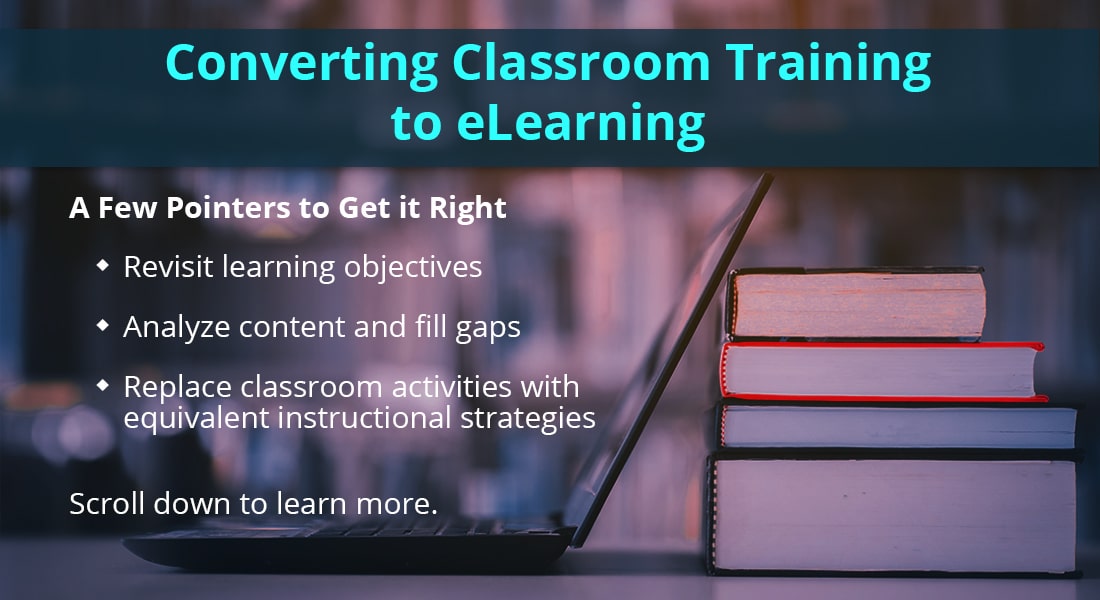3 Steps for the Perfect Blend of Classroom and Online Product Training
Product training for the sales team is an ongoing affair. The sales reps need to be up-to-date on product information and retain a competitive edge over the others. However, given their hectic schedules, it is quite difficult to have just the traditional classroom training. In this blog, let’s look at how you can blend classroom and online learning for product training.

Product training for the sales team is an ongoing affair. Sales reps need to be up-to-date on product information and retain a competitive edge over their competitors. However, given their hectic schedules, it is quite difficult to have just the traditional classroom training. Many factors are involved in the making of a training program. It requires a long-term investment of time, money, and resources. However, they don’t guarantee a successful product training program. There are many factors to be considered before beginning a training program;blended learning is the best solution when it comes to training workforce on the go.
You must be well aware that blended learning is a dynamic blend of classroom training and online training methods. Online learning can be in the form of e-learning or mobile learning which can be accessed on laptops, tablets, or mobile devices. This easy accessibility is a great asset for product training. In this blog, let’s look at how you can blend classroom and online learning for product training.
Plan for a Blended Approach
Before you dive into developing your training program, you need to plan the approach. Have a systematic approach that ensures you choose the right blend that will prove useful for your learners. For a blended approach, you need to:
- Identify what has to be taught and through ILT and
- Focus on the learning objectives
- Research learner needs and preferences
- Set the goals and expectations
- Set a flexible implementation strategy
- Develop effective assessments
- Focus on the technology tools to be used
- Offer online support resources
Your primary focus should be on the learning objectives. Analyze if your aim is to create awareness of the product or provide a real-world experience to learners. Then analyze the content type and classify if the training is based on facts, concepts, or procedures. Once the content is analyzed, focus on the delivery method, how you would like to convey each part – in the classroom, through videos or simulations, etc. This depends on the types of learners; therefore, a thorough learner analysis has to be conducted. Consider these scenarios: Are your learners always on the go? Are they beginners or experts in the field? Are they comfortable with eLearning? Once you are able to answer these questions, you will be able to plan for a blended learning approach accordingly.
Integrate ILTs with E-learning
Let’s begin with an example. Consider this: Assume that a new medical equipment has been launched. Sales reps have to demonstrate the working of the product to customers and clients, so they need to have thorough knowledge of the equipment. Reading manuals and watching videos will help to a certain extent. However, a live demonstration from an expert makes it easier to understand.
For instance, instead of watching a software simulation, learners can directly watch an expert demonstrate and try the simulations in a self-paced environment for practice. In a classroom session, you could have role plays, group discussions, and enactments from the instructor and trainees. Apart from that, you could also have videos, which can be used for reinforcement.
So, you need to decide on what to include as part of the classroom and what to deliver online, based on the type of training and the learners. Not every feature of a product can be taught in solely in the class or online. There are times when products are way too complex and cannot be taught online. At such times, classroom learning and group discussions are helpful. On the other hand, there are times when products could be expensive and a real demo could cause more damage. In such situations, you can use online learning in the form of videos or simulations.
There are three primary ways to integrate classroom training with eLearning.
- Pre-classroom training – You can give preparatory online learning material learners can discuss during the classroom session. For instance, while training sales reps, you could give them the product specs as an online module or an infographic that would be discussed during the classroom session. In the classroom session, you could have a role-play getting two learners to essay the roles of a rep and a customer.
- Post-classroom training – This can be done in the form of refresher courses, to help learners retain what they have learned. For instance, you could provide your reps with job-aids such as, infographics, interactive PDFs, checklists, etc., that provide information at the time of need.
- In-classroom training – There are certain online activities and assessments that can be done during the classroom session. Portions that are online can be included in the classroom session.
Practice the Perfect Blend
Creating the perfect blend depends on following a systematic practice. Let’s break it down to the 3 As to be followed – Align, Assess & Achieve
Align – Align the training program with the business objectives (increased sales, improved customer service, etc.)
Assess – Assess the needs of learners and their preferences (What is the performance gap the training aims to bridge and how can it be imparted. Also assess what content can be presented in the classroom and what can be presented through eLearning formats.)
Achieve – Create the perfect blend and achieve the results – thorough learning and reinforcement (Choose the right approach to ensure learners are comfortable and are motivated to achieve the desired results.)
You can bring about a whole new dimension to learning if you practice the right blend. You can personalize your blended learning approach to match the needs of learners. Remember, there are no set rules. You are free to choose your blend.





